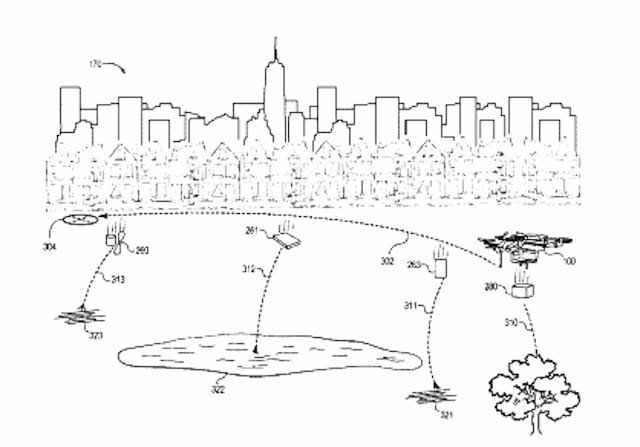
A troubled Amazon delivery drone sheds parts in a patented procedure (U.S.
Patent and Trademark Office)
Amazon has just received a patent outlining a possible plan for “directed fragmentation for unmanned airborne vehicles” used in deliveries.
“The use of UAVs is accompanied by the need for new solutions to various problems, such as service disruptions due to unsuitable weather conditions, equipment malfunctions, and other problems,” said the text of the patent, which the Seattle firm applied for in June 2016 and received Tuesday.
Amazon, which relies extensively on other businesses such as FedEx and UPS to deliver its packages, is pushing hard to turn the fantasy of drone delivery into reality. To accomplish this revolution in shipping, the company has established “Amazon Prime Air” and invested heavily in drone research and development, filing for patent after patent on everything from parachute drops of ordered goods to rotor blades that minimize the aircrafts’ typically piercing whine.
Critical to the latest patent is a “fragmentation sequence” that the drone constantly updates with an eye on flight path, flying conditions and what lies in the terrain below, to determine “preferred locations” for dropping parts.
“For example, the terrain topology information can identify bodies of water, forested areas, open fields, and other locations more suitable for dropping components of the UAV if or when flight operation errors, malfunctions, or unexpected conditions occur,” the patent document said.
Among the proposed mechanisms for separating components are small explosive charges, and the system could even jettison the cheapest drone parts first.
Along with finding preferred drop locations, the drone system would identify and avoid areas not conducive to raining bits of machinery from the sky, including residential and commercial areas, roadways, schools and stadiums.
As for what might compel an Amazon delivery drone to divest itself of various parts, the patent document provided a rundown, citing wind, hail, rain, particularly hot or cold temperature and atmospheric pressure levels. Also, the document noted, critical drone components “can unexpectedly malfunction or fail for various reasons.”
The patented technology does not aim to have an entire drone fall to pieces. Rather, it would lose one or more parts to alter the drone’s weight, speed and shape, and to adjust the aircraft’s momentum and trajectory for an optimal controlled descent.
The drone’s systems would allow it to control where the parts fall, so they would land in preferred locations.
The illustration accompanying the patent indicates those locations could include a pond and a tree. The drawing also appears to show a drone dropping the cargo into a tree.
Parts could be released using latches, hooks or springs, “small explosive charges” or compressed gas.
There’s attention to cost, among other factors, in what gets jettisoned.
“The fragmentation sequence engine can select the order based on various factors, such as the replacement value or cost of the components, the air drag coefficients of the components, the weight of the components, the purpose of the components, and other factors,” the patent document said.
However, just because Amazon patented this system — which also seems unsuitable for urban centers — that doesn’t guarantee it will go into action. Still, the company is recognizing the possibility for “catastrophic failure” of a delivery drone, and that indicates that some solution is needed before Amazon starts delivering goods via drones.
Source: The Mercury News
